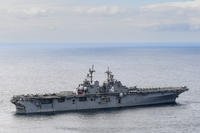 This article first appeared in Defense Technology International.
This article first appeared in Defense Technology International.
One of the most ambitious forecasting projects of late is the U.S. Air Force's Blue Horizons II, which wrapped in 2008, and was presented at a conference here in May by Col. John Geis, director of the Center for Strategy and Technology at Maxwell AFB, Ala.
Ambitious? How does a giant nuclear-powered flying laser sound; or a hypersonic bomber that launches satellites; or a tactical fighter firing laser and microwave beams?
The project began in 2005 because 10 years had passed since the last such venture, Air Force 2025. Conducted by USAF's Air University, Blue Horizons II was led by seven faculty members aided by 49 researchers. Seven out of 10 people involved, Geis notes, were "rated operators" of Air Force systems.
The goal was to determine what technologies USAF would be best advised to support. The starting point was a range of possible future scenarios for global conflict. The next step was to evaluate capabilities, from the near-term to the futuristic, in each scenario. Finally, the team looked at what basic technologies would be needed to provide those capabilities.
The team picked four scenarios: a peer China, Middle East jihadist insurgency, failed state and a resurgent Russia. No real surprises. Geis emphasized that "China will be the supreme power on earth by 2040." The study envisioned China having the world's largest GDP by 2030, although "militarily it will take some time after that for them to catch up." Internal dissent and China's demand for energy and food will be potential sources of international friction.
One surprise was a finding that runs counter to accepted wisdom at top levels of the Pentagon: The same capabilities, by and large, proved to be most valuable in all scenarios -- that is, there was no dichotomy between low-tech counterinsurgency weapons and what the Air Force would use to discourage antisocial behavior by China's future leaders. Where there was a difference, it was for specific reasons. The study participants, for example, don't expect non-state actors to develop counterspace weapons, so systems that were aimed at defeating such attacks scored low in insurgent and failed-state scenarios.
The overall top-scoring weapon concept was a UAV dubbed Pathfinder, an autonomous, stealthy vehicle incorporating powerful electronic jamming arrays, which could launch and control smaller UAVs, or operate as an autonomous wingman to manned aircraft.
Second on the list was a "cyberspace UAV," an autonomous antivirus program that propagates over the Internet and detects cyberthreats before they affect U.S. defense systems.
After that came three lasers: a hybrid high-energy laser based in the U.S. and directed by spaceborne mirrors to destroy soft-to-medium ground targets; a space-based, solar-charged solid-state laser for missile defense; and a future airborne laser (FAL).
FAL is a huge nuclear-powered flying wing with a range of 80,000 naut. mi. that is capable of engaging soft targets like missiles at several hundred kilometers. Geis accepts that airborne nuclear power could be a political nonstarter, but says FAL would also be feasible with advanced conventional propulsion.
Of the top 10 concepts, five were unmanned vehicles and five used directed-energy weapons (DEW). Only five were kinetic attack systems and three of those were supercruisers or faster -- the study found that a supersonic bomber was more valuable than a subsonic design. Another widely applicable use of DEW was aircraft self-defense, which ranked as the second most important group of technologies in the AF2025 study and placed third in Blue Horizons II.
Read the rest of this story, check out the Navy's new UAV outlook, see why making a pilot optional is so darned good and soar with the long endurance UAVs with our friends at Aviation Week, exclusively on Military.com.
-- Christian








